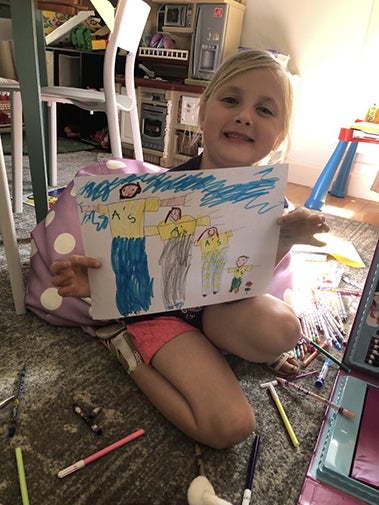'An Incredible Experience for the Children.' How the Preschool Learning Lab Went Virtual

When the coronavirus pandemic necessitated a switch to online learning, the staff at the Preschool Learning Lab thought long and hard about how to keep the program going.
The Preschool Learning Lab, which is part of the Psychology and Child Development department, is a functioning preschool and part of a lab class for students in the child development major. The staff decided to move the preschool online, hoping to facilitate the Child Development Preschool Lab course (CD230) as well as provide structure for the preschool-age children and their families, whom the staff had built relationships with since the fall.

“We wanted to make sure our CD230 students could have access to the children and the families could participate and maintain relationships during the shelter-in-place order,” said Patty Clarkson, director of the Preschool Learning Lab. “We didn’t have a framework for offering a fully-online preschool program because preschool is based on in-person relationships and hands-on activities. However, we knew that our preschool families wanted to stay connected and wanted their children to be engaged in learning activities.”
The Preschool Lab’s team surveyed families and asked them about their needs and timeframes, using those responses as a guideline.
“We wanted to emulate the foundational building blocks of our day as much as we could,” Clarkson said.
Clarkson and the preschool’s two full-time teachers, Kari Applegate and Shondrela Braggs-Jones, came up with a plan: a virtual group meeting every morning, along with music and movement time, which lasted about 30 minutes to an hour. In the afternoons, they hosted half-hour Zoom sessions where they would read to the kids from a chapter book before their rest time.
“These two daily activities gave the children a sense of normalcy and routine, during which they could connect with their teachers, see their classmates and continue their explorative learning through daily challenges and activities,” Clarkson said.
None of the Zoom sessions were required for the preschool children, and were meant to act as a structure that they and their families could take advantage of as needed. Applegate brought some of the items from the preschool, such as a whiteboard that they wrote their daily agenda on, to her house to mimic the school setting.
“Parents told me, ‘Once we saw the agenda board, we felt like everything was okay, that there was a sense of normalcy,’” Applegate said.
The teachers also offered one-on-one sessions to children and families.
“Some kids get overwhelmed by so many people on a Zoom call, and some families have limited screen time expectations, so the children could make virtual appointments with us individually,” Clarkson said. “The children were free to just hang out with their teacher and have us along with whatever they were doing in that time frame.”
Applegate and Braggs-Jones also offered the children “challenges” to complete between classes, which included things like exploring outside to identify creatures or plants around their homes, or drawing a family portrait. The next day, the kids would then take turns sharing their work with the whole group.

“We were thoughtful about doing things that didn’t require a lot of material or things parents would have to work to gather,” Applegate said. “It was however they wanted to do it; it was flexible. It was okay to not have the work done, we just appreciated that everyone was feeling connected.”
The virtual setting also had an unexpected benefit for the college students who would usually be interacting with the children and staff in person, as they were able to participate in the Zoom sessions and then debrief with staff afterward, Applegate said.
“It was a neat experience to get to know the college students better,” Applegate said. “By the end of the Zoom quarter, they were helping us with the challenges and got to be part of that process.”
Peggy Osborn, whose grandson, Edro, attended the preschool this past year, said she was impressed with how the preschool handled the move to a virtual environment.
“As a retired teacher, I thought, ‘How is this ever going to work?’” Osborn said. “I can’t praise the Learning Lab enough. It’s been an incredible experience for the children, every morning they got to see each other and every afternoon they got to see each other.”
Edro adjusted well to Zoom, and it was an “amazing experience” for the both of them, Osborn said.
“He doesn’t always have the best time with changes, but he was okay,” she said. “He did well. I’m proud of him.”
Osborn added that she didn’t think the virtual preschool would have been nearly as successful if it weren’t for the caliber and dedication of Clarkson, Applegate and Braggs-Jones.
“They are remarkable teachers and they are so kind and gentle with these children,” Osborn said.

Anna Brannen’s daughter, Evelyn, thrived in the virtual learning environment. Originally, she attended the Zoom sessions twice a week, but soon asked to go every day.
“It offered the kids a lot of social time. They got to talk to each other and see each other, and it gave Evelyn a lot of structure,” Brannen said. She added that she noticed her daughter’s artistic side coming out during the challenges as well.
“Everything was built upon the skills she had,” Brannen said. “It brought out a lot of creativity in her and brought out a lot of questions. She really thrived in this type of environment, which I wasn’t expecting.”
Brannen was also complimentary of the preschool’s staff and the college students.
“Their lives got uprooted as well but they really took the time to make sure every day had a plan, a follow-up plan for homework, and they showed up how you would expect them to at school,” Brannen said. “I don’t even know how to verbalize how much it helped us get through the last three months.”




